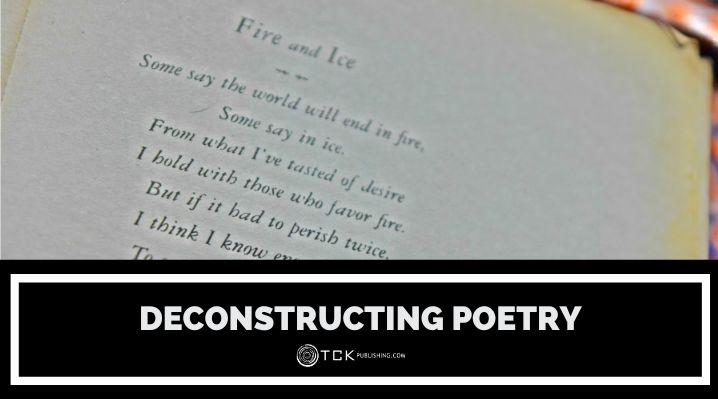
A piece of poetry is a story condensed into short language. To circumnavigate the usual linguistic limitations, it uses figurative language, rhythm, and distinctive styles to illustrate its meaning.
It is a heavily personal art form, making it difficult to interpret even with the right approach. Its meaning may even depend not just on the poet, but also their audience.
What is Poetry?
Poetry is literature that is written in verse. At its core, it aims to capture and convey emotions, ideas, and experiences in a way that resonates with the reader.
It achieves this goal through different poetic techniques such as rhyme, rhythm, figurative language, and structure.
Unlike prose, poetry is a more concentrated way of using language. It often focuses on the beauty of words and how they sound and look on the page. It also often breaks the rules of grammar and sentence structure to achieve certain effects.
Poetry comes in different forms, some more easily defined than others. The more recognizable ones include the limerick, sonnet, and haiku. Other poems are written to be experimental, due to a need to escape the logical or deviate from traditional expectations of the art.
Deconstructing Poetry
Analyzing poetry can be a difficult task. Poets can create so many layers of meaning through word choice, rhyme scheme, rhythm, and form. Even a simple line break can change a stanza’s interpretation.
It’s why analyzing poetry can be difficult. Here are some tips to help you out.
1. Read it in its entirety.
When studying poetry, don’t immediately dive into peeling back its layers. Experience it how the poet intended it to be.
Read it aloud or find a recording to listen to. Poets compose poems with rhythm and wordplay—elements that are easy to miss during silent reading. Do multiple readings if you need to.
You don’t need to understand the poem yet or pay attention to its technical details. You simply need to get a sense of it and feel the emotion within the poet’s words.
2. Identify the narrators, audience, and setting.
Remember, the speaker of a poem is not necessarily the poet. It can be a certain character, an object, or even an imaginary voice.
Who are they speaking to? Does the speaker or audience change at some point? Where and when does the poem take place? What cultural or historical elements affect the character’s behavior?
A poem’s actors and setting can provide valuable insights into its meaning.
3. Unpack the language.
Pay close attention to the words being used and how they are used. See how these words are used individually, as part of a line, then a sentence, and finally within the stanza.
Poets often use figurative language to make comparisons, and references, and evoke imagery. Being a work of compressed language, every word is important.
Most poems also have a narrative element to them. Learning the meaning behind the poet’s words will help you understand the story.
There will be certain elements that you either can’t figure out or may have multiple meanings. That’s okay! Note any unfamiliar words, literary techniques, and vague parts. You’ll learn the poem’s deeper meanings the more you re-analyze it.
4. Find its central theme.
Ask yourself what the poem is about and what the poet is trying to say. This is typically the theme or the message.
Look at what connects all the elements. Find symbols and recurring motifs that either represent or emphasize certain meanings. Consider the significance of the title and why the poet chose it.
It’s also helpful to consider the poets themselves. What inspired them to write the poem? What situation were they in? What were they feeling while composing their piece?
5. Tone and Mood
Tone is the attitude or emotional state of the speaker. Mood is the feeling the poem creates within the reader.
Is the poem serious or playful? Does the poet’s word choice evoke certain emotions? Understanding the tone and mood of a piece can reveal its meaning, and vice versa.
6. Break it down into its components.
Study the poem’s rhythm, structure, and determine its form. Read it by line, by sentence, and finally, by stanza.
How many syllables in a line? How many lines are in a stanza? If a sentence is split into two lines, where is the line break, and why there? What metric pattern did the poet use? How is the poet adhering to or challenging a particular form’s conventions?
Each structural component contributes to how the poem sounds, what it means, and how it is interpreted.
7. Annotate.
With so many things to consider, you can easily get overwhelmed by details, tangential thoughts, and questions. Annotation is your best friend.
Highlight lines that stand out. Write down unfamiliar words. Point out certain repetitions or inconsistencies. Jot down anything you think will help you better understand the poem.
Use a pencil so it’s easy to make corrections or alterations. Poetry analysis is a process that will often require you to make changes.
Poetry Analysis
Poetry is a powerful medium for delving into human experiences, expressing emotions, and conveying certain truths. Naturally, a lot of poems end up with a complexity that can be daunting to explore.
However, exploration is part of why poetry is so satisfying. Multiple people can start at the same point but end up in different places. You discover unique meanings based on your own perspectives, experiences, and interpretations of the poet’s words.
Have you tried analyzing a piece of poetry? Share your experience below!
If you enjoyed this post, then you might also like:
- What Is Found Poetry? Examples and Tips for Making Your Own Found Poem
- 8 Japanese Poetry Styles Aside from the Haiku
- How to Rhyme: Types, Examples, and Tips for Rhyming in Poetry and Music
- 8 Lesser-Known Forms of Eastern Poetry

Cole is a blog writer and aspiring novelist. He has a degree in Communications and is an advocate of media and information literacy and responsible media practices. Aside from his interest in technology, crafts, and food, he’s also your typical science fiction and fantasy junkie, spending most of his free time reading through an ever-growing to-be-read list. It’s either that or procrastinating over actually writing his book. Wish him luck!
